
FOX (FOXA)
FOX is up against the odds. Its weak sales growth and low returns on capital show it struggled to generate demand and profits.― StockStory Analyst Team
1. News
2. Summary
Why We Think FOX Will Underperform
Founded in 1915, Fox (NASDAQ:FOXA) is a diversified media company, operating prominent cable news, television broadcasting, and digital media platforms.
- Large revenue base makes it harder to increase sales quickly, and its annual revenue growth of 5.9% over the last five years was below our standards for the consumer discretionary sector
- Earnings growth underperformed the sector average over the last five years as its EPS grew by just 11.3% annually
- Sales are projected to remain flat over the next 12 months as demand decelerates from its two-year trend


FOX doesn’t pass our quality test. There’s a wealth of better opportunities.
Why There Are Better Opportunities Than FOX
High Quality
Investable
Underperform
Why There Are Better Opportunities Than FOX
FOX is trading at $73.87 per share, or 16.1x forward P/E. This multiple is lower than most consumer discretionary companies, but for good reason.
Cheap stocks can look like a great deal at first glance, but they can be value traps. They often have less earnings power, meaning there is more reliance on a re-rating to generate good returns - an unlikely scenario for low-quality companies.
3. FOX (FOXA) Research Report: Q3 CY2025 Update
Cable news and media network Fox (NASDAQ:FOXA) reported Q3 CY2025 results beating Wall Street’s revenue expectations, with sales up 4.9% year on year to $3.74 billion. Its non-GAAP profit of $1.51 per share was 37.4% above analysts’ consensus estimates.
FOX (FOXA) Q3 CY2025 Highlights:
- Revenue: $3.74 billion vs analyst estimates of $3.57 billion (4.9% year-on-year growth, 4.6% beat)
- Adjusted EPS: $1.51 vs analyst estimates of $1.10 (37.4% beat)
- Adjusted EBITDA: $1.07 billion vs analyst estimates of $843.3 million (28.5% margin, 26.3% beat)
- Operating Margin: 28.5%, up from 26.7% in the same quarter last year
- Free Cash Flow was -$234 million, down from $94 million in the same quarter last year
- Market Capitalization: $25.61 billion
Company Overview
Founded in 1915, Fox (NASDAQ:FOXA) is a diversified media company, operating prominent cable news, television broadcasting, and digital media platforms.
FOX was initially established to meet early 20th-century demands for entertainment and news. Over the decades, the company has significantly evolved, branching into various media segments and adopting digital platforms.
FOX provides a broad spectrum of media services including news coverage, sports broadcasting, and other entertainment. FOX caters to a large audience, seeking engagement with diverse viewers, from news aficionados to entertainment consumers.
The company's revenue is primarily derived from advertising, subscription fees, and content licensing. Furthermore, it must produce quality content to maintain its channel space.
A notable aspect of FOX's value proposition is its focus on delivering content that resonates with specific viewer segments, particularly those seeking a certain perspective on news and entertainment. This targeted content strategy has enabled FOX to carve out a niche in the competitive media landscape.
4. Broadcasting
Broadcasting companies have been facing secular headwinds in the form of consumers abandoning traditional television and radio in favor of streaming services. As a result, many broadcasting companies have evolved by forming distribution agreements with major streaming platforms so they can get in on part of the action, but will these subscription revenues be as high quality and high margin as their legacy revenues? Only time will tell which of these broadcasters will survive the sea changes of technological advancement and fragmenting consumer attention.
Competitors in the media and entertainment industry include Comcast Corporation (NASDAQ:CMCSA), Walt Disney (NYSE:DIS), and Paramount Global (NASDAQ:PARA).
5. Revenue Growth
A company’s long-term sales performance is one signal of its overall quality. Any business can experience short-term success, but top-performing ones enjoy sustained growth for years. Over the last five years, FOX grew its sales at a sluggish 5.9% compounded annual growth rate. This fell short of our benchmark for the consumer discretionary sector and is a poor baseline for our analysis.
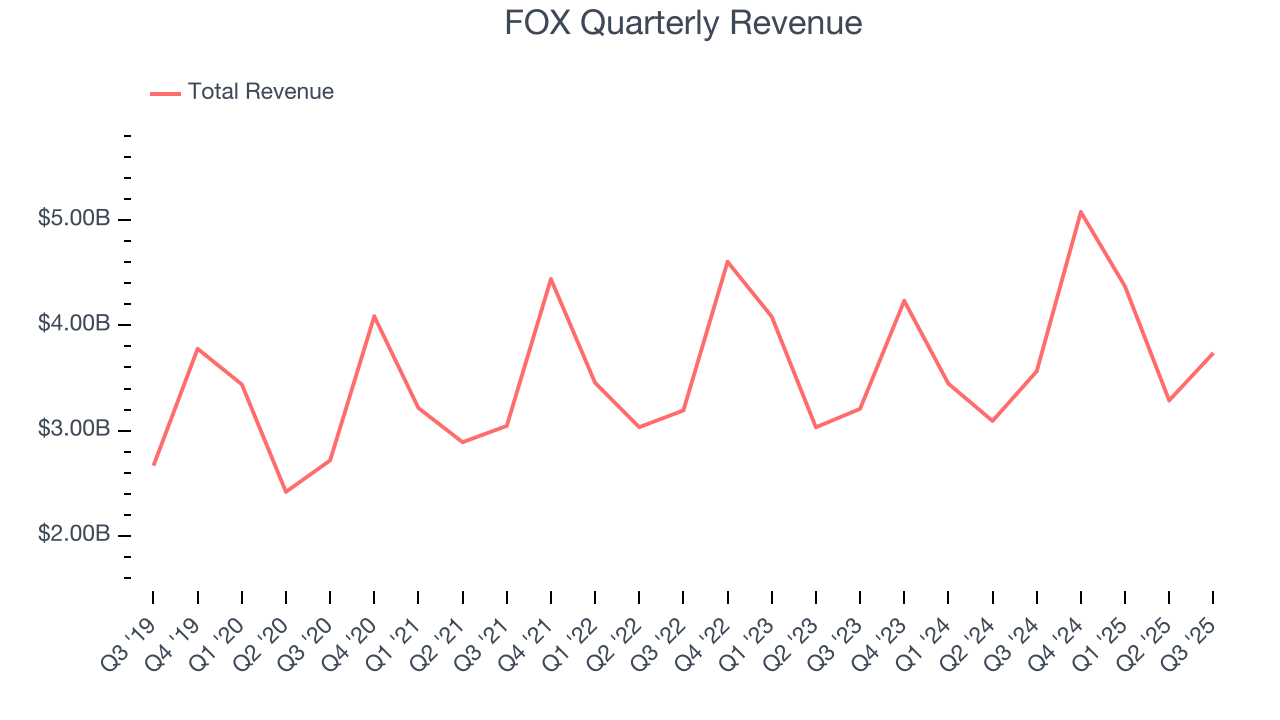
Long-term growth is the most important, but within consumer discretionary, product cycles are short and revenue can be hit-driven due to rapidly changing trends and consumer preferences. FOX’s annualized revenue growth of 5.1% over the last two years aligns with its five-year trend, suggesting its demand was consistently weak. 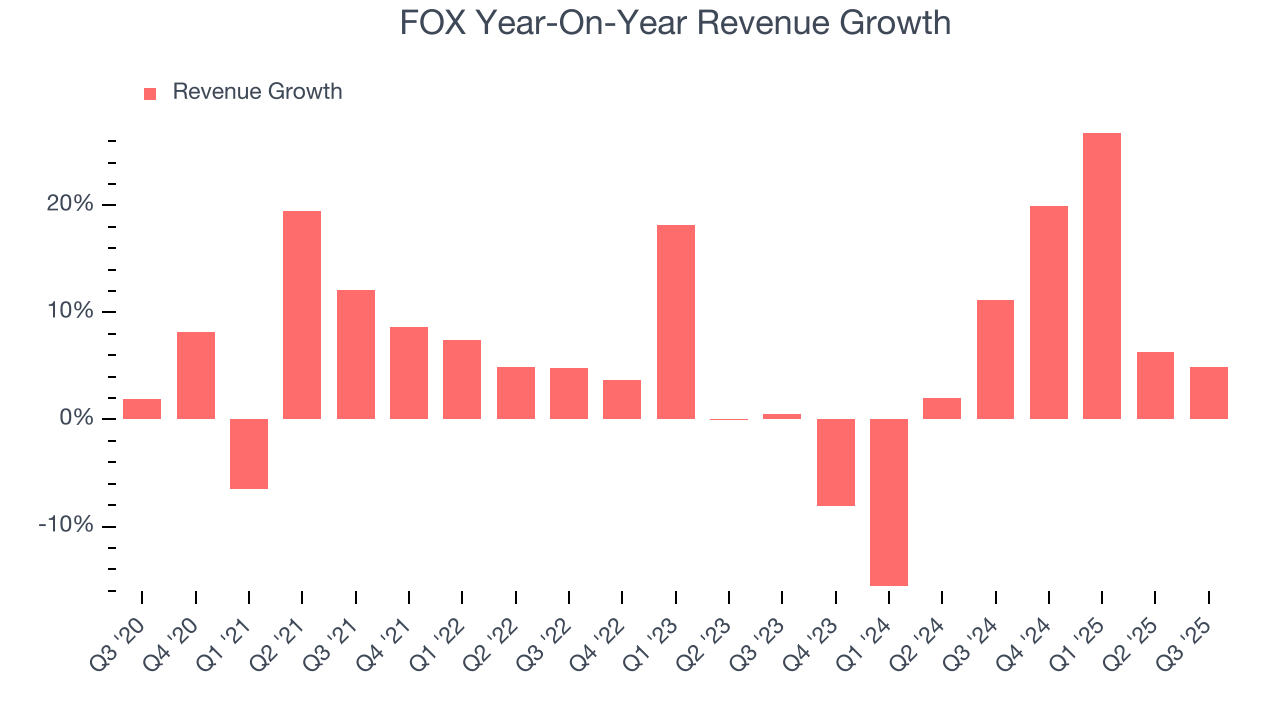
We can dig further into the company’s revenue dynamics by analyzing its most important segments, Advertising and Affiliate, which are 37.8% and 51.2% of revenue. Over the last two years, FOX’s Advertising revenue (marketing services) averaged 7% year-on-year growth while its Affiliate revenue (licensing and retransmission fees) averaged 4.5% growth. 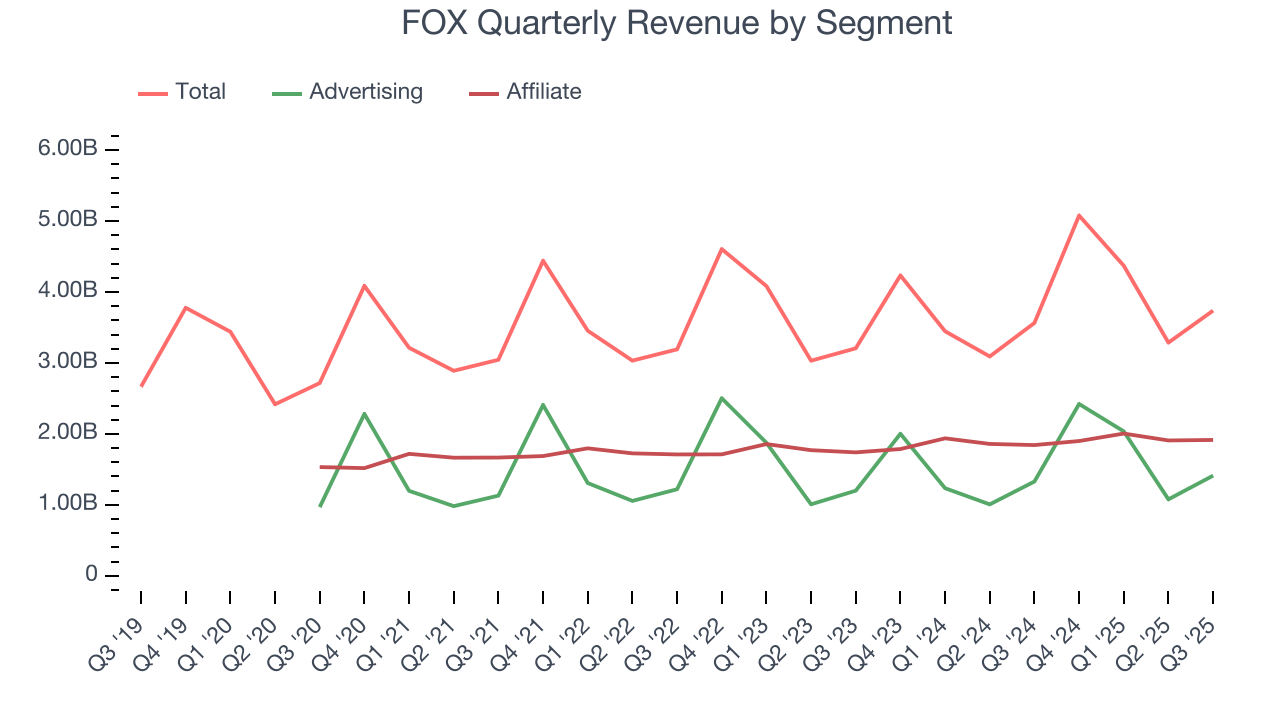
This quarter, FOX reported modest year-on-year revenue growth of 4.9% but beat Wall Street’s estimates by 4.6%.
Looking ahead, sell-side analysts expect revenue to decline by 1.7% over the next 12 months, a deceleration versus the last two years. This projection is underwhelming and implies its products and services will see some demand headwinds.
6. Operating Margin
FOX’s operating margin has been trending up over the last 12 months and averaged 19.5% over the last two years. On top of that, its profitability was top-notch for a consumer discretionary business, showing it’s an well-run company with an efficient cost structure.
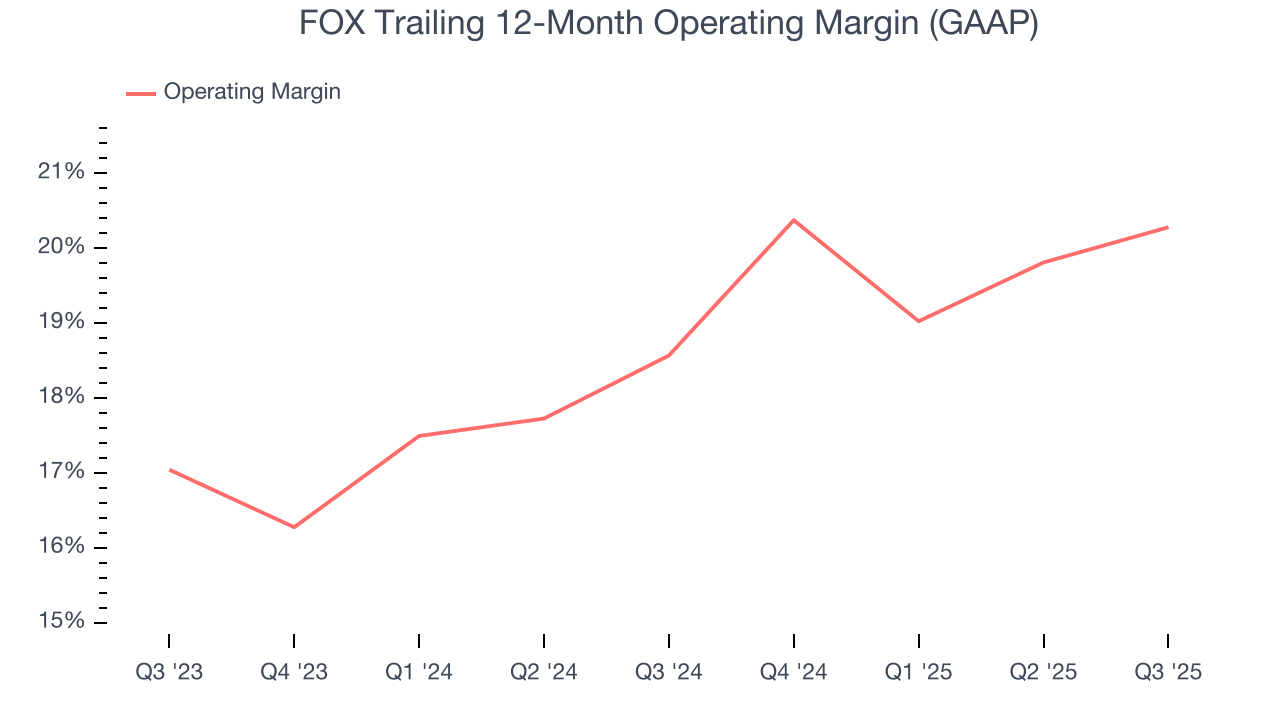
This quarter, FOX generated an operating margin profit margin of 28.5%, up 1.8 percentage points year on year. This increase was a welcome development and shows it was more efficient.
7. Earnings Per Share
We track the long-term change in earnings per share (EPS) for the same reason as long-term revenue growth. Compared to revenue, however, EPS highlights whether a company’s growth is profitable.
FOX’s EPS grew at a decent 11.3% compounded annual growth rate over the last five years, higher than its 5.9% annualized revenue growth. However, this alone doesn’t tell us much about its business quality because its operating margin didn’t improve.
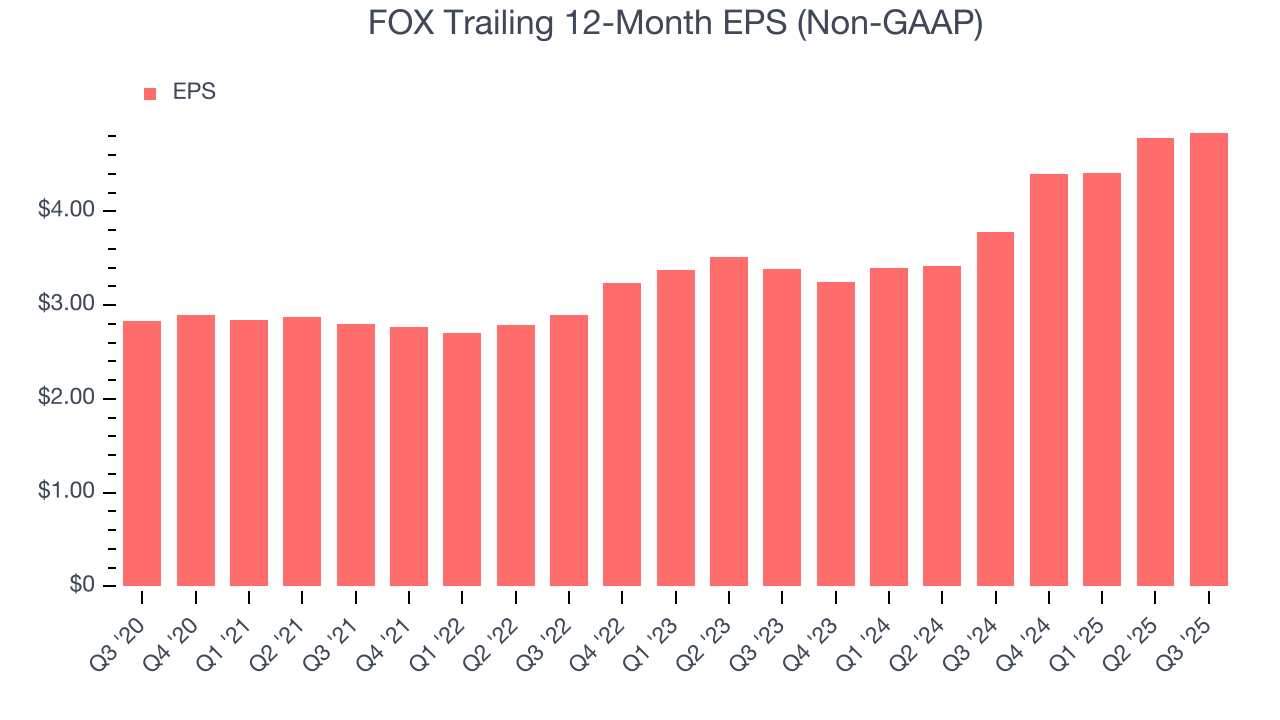
In Q3, FOX reported adjusted EPS of $1.51, up from $1.45 in the same quarter last year. This print easily cleared analysts’ estimates, and shareholders should be content with the results. Over the next 12 months, Wall Street expects FOX’s full-year EPS of $4.84 to shrink by 8.1%.
8. Cash Is King
Although earnings are undoubtedly valuable for assessing company performance, we believe cash is king because you can’t use accounting profits to pay the bills.
FOX has shown impressive cash profitability, giving it the option to reinvest or return capital to investors. The company’s free cash flow margin averaged 14% over the last two years, better than the broader consumer discretionary sector.
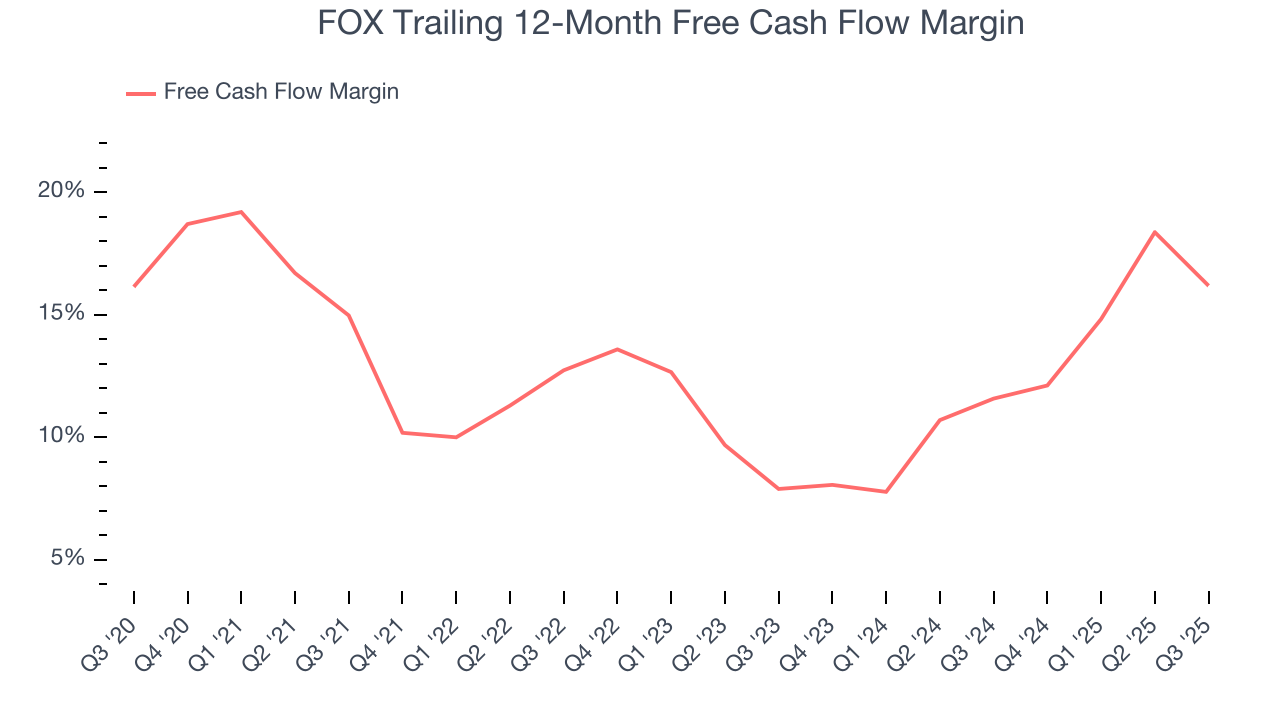
FOX burned through $234 million of cash in Q3, equivalent to a negative 6.3% margin. The company’s cash flow turned negative after being positive in the same quarter last year, prompting us to pay closer attention. Short-term fluctuations typically aren’t a big deal because investment needs can be seasonal, but we’ll be watching to see if the trend extrapolates into future quarters.
Over the next year, analysts predict FOX’s cash conversion will fall. Their consensus estimates imply its free cash flow margin of 16.2% for the last 12 months will decrease to 13%.
9. Return on Invested Capital (ROIC)
EPS and free cash flow tell us whether a company was profitable while growing its revenue. But was it capital-efficient? A company’s ROIC explains this by showing how much operating profit it makes compared to the money it has raised (debt and equity).
FOX’s management team makes decent investment decisions and generates value for shareholders. Its five-year average ROIC was 16.5%, slightly better than typical consumer discretionary business.
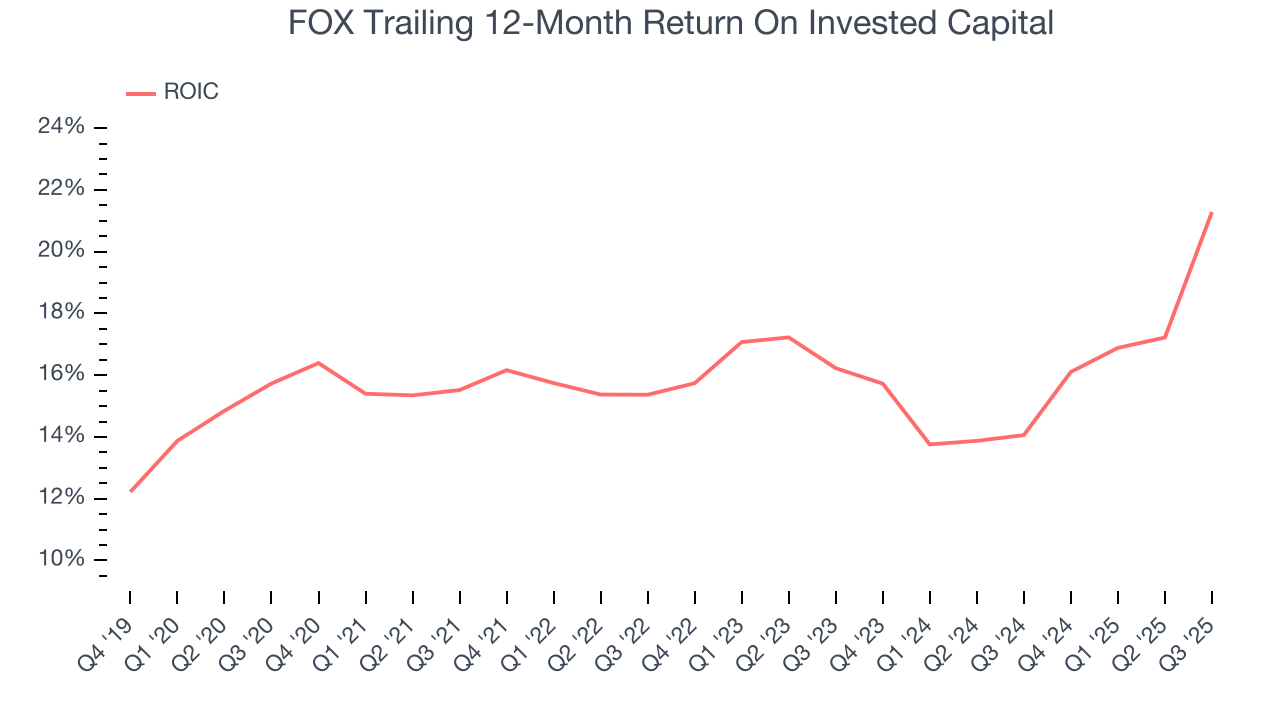
We like to invest in businesses with high returns, but the trend in a company’s ROIC is what often surprises the market and moves the stock price. Over the last few years, FOX’s ROIC averaged 2.2 percentage point increases each year. This is a good sign, and we hope the company can keep improving.
10. Balance Sheet Assessment
FOX reported $4.37 billion of cash and $6.6 billion of debt on its balance sheet in the most recent quarter. As investors in high-quality companies, we primarily focus on two things: 1) that a company’s debt level isn’t too high and 2) that its interest payments are not excessively burdening the business.
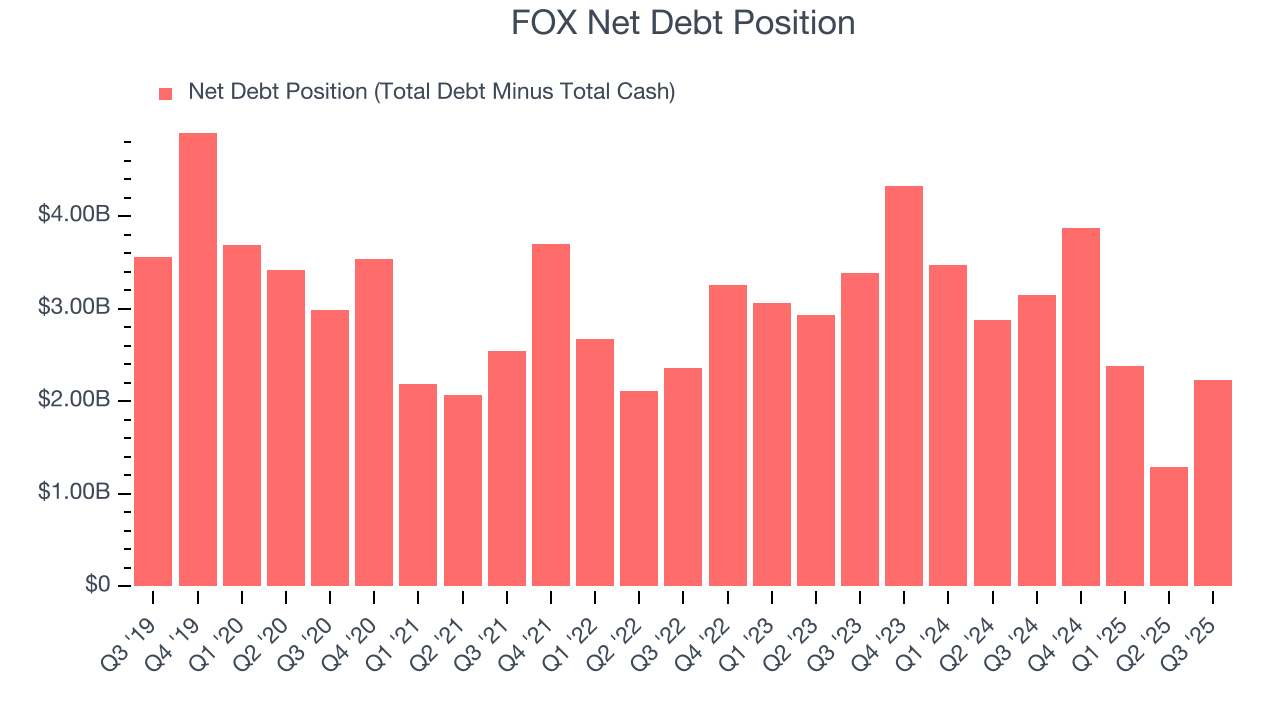
With $3.64 billion of EBITDA over the last 12 months, we view FOX’s 0.6× net-debt-to-EBITDA ratio as safe. We also see its $227 million of annual interest expenses as appropriate. The company’s profits give it plenty of breathing room, allowing it to continue investing in growth initiatives.
11. Key Takeaways from FOX’s Q3 Results
It was good to see FOX beat analysts’ EPS expectations this quarter. We were also excited its EBITDA outperformed Wall Street’s estimates by a wide margin. Zooming out, we think this was a solid print. The stock traded up 4.3% to $63.47 immediately following the results.
12. Is Now The Time To Buy FOX?
Updated: December 24, 2025 at 10:06 PM EST
A common mistake we notice when investors are deciding whether to buy a stock or not is that they simply look at the latest earnings results. Business quality and valuation matter more, so we urge you to understand these dynamics as well.
We cheer for all companies serving everyday consumers, but in the case of FOX, we’ll be cheering from the sidelines. To begin with, its revenue growth was weak over the last five years, and analysts expect its demand to deteriorate over the next 12 months. On top of that, FOX’s Forecasted free cash flow margin suggests the company will ramp up its investments next year, and its weak EPS growth over the last five years shows it’s failed to produce meaningful profits for shareholders.
FOX’s P/E ratio based on the next 12 months is 16.1x. This valuation is reasonable, but the company’s shaky fundamentals present too much downside risk. There are superior stocks to buy right now.
Wall Street analysts have a consensus one-year price target of $73.22 on the company (compared to the current share price of $73.87).







